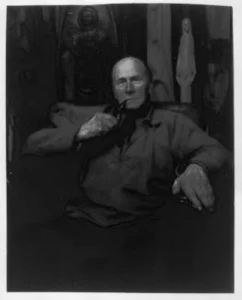Biography of Henri-Paul Rey

Henri-Paul Rey studied under Georges Laithier and Léon Tirode, Jean-Antoine Injalbert, and Roger de Villiers at the School of Fine Arts in Besançon between 1925 and 1927. In 1927 and 1933, he studied under Henri Bouchard at the School of Fine Arts of Paris, where he also picked up the critical techniques that would characterize his original, imaginative works. Rey was skilled at imposing his style on his figures right away, without requiring extended engagement or other influences.
The birthplace of Henri-Paul Rey is Pesmes, France. He was a sculptor who used a lot of ceramics along with stones and wood for his work.
At that time, Henri Rey’s visually arresting and satisfyingly sophisticated work was refreshing before to the conflict at that time. One of his artistic creations, a wooden base assistance, was displayed in the 1937 Special Exhibition at the Pavillon de Franche-Comté. He also displayed a figure named Tree of Peace at the 1939–1940 New York International Fair. He participated in the Salon des artiste’s français on a regular basis, winning gold in 1937, silver in 1933, and bronze in 1932. He is one of the members of the Salon des Arts Décoratifs jury.
A cubist second era is required for Henri-Rey. He creates works with dance and music and carves incredible pieces of wood. His art conveys affectivity and emotion. With meticulous attention to detail and a unique, groundbreaking maternal delicacy, he created his modified totems carved from trees. trunks. He is impacted by the first African craft in the same manner as other cubists from earlier eras.
The exhibition halls at Paris, Besancon Dijon, Dijon, Pontailler Sur Saone, and Arles, France, as well as the United States, Canada, Poland, and other international foundations, safeguard the works of Henri-Paul Rey.
He primarily works in his home region, where he can visit famous sites like Louis Pergaud Fresnes-en-Woëvre (Meuse), Saint-Ferréol and Saint-Ferjeux in the Basilica of Monseigneur Dubourg’s tomb, or the Virgin of Boxwood in Besançon, where the enormous model—seven meters high—combines religious craftsmanship at such a commanding site, overlooking the settlement! In addition to Saint, the magnificent Church of Pesmes is also affluent with Rey’s works, features Saint Hilaire design as well.
Journalists, lawmakers, painters, such as Louis Lumiere, Louis Guignard, Édouard Belin, Cardinal Binet, President Jules Grévy, and Auguste Pointelin, are among the figures that Rey busts and embroiders.
The recipient of the 1971
Global Prize for Figure and Arts from the Academy of Letters, Sciences, and Arts of Besançon is Henri-Paul Rey.
Several historical institutions, including the Musée de Paris, Besançon, Arles, and Dijon Poutailier, purchased works by Henri-Paul Rey.